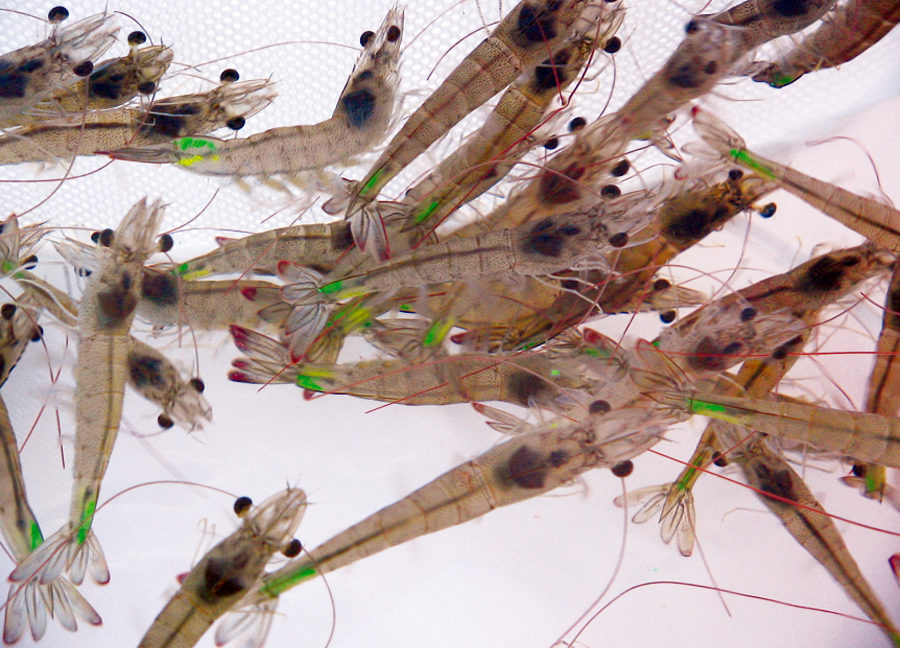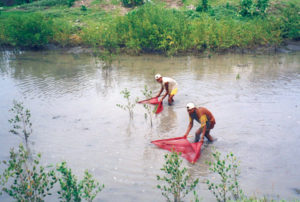Summarized from The Shrimp Book

Shrimp farming is a young and dynamic business with a history of rapid change in response to technological advances. The first breakthroughs in shrimp-farming technology occurred in Japan during the late 1930s, but Japan’s climate and species were not suitable for large-scale production. During the 1970s, Japan’s technology was transferred to other countries in Asia and the Americas. The top shrimp-producing countries are listed in Table 1.
The history of shrimp farming is analogous to that of terrestrial animal husbandry, where traditional culture of wild animals at low density in a natural setting progressed to intensive culture of domesticated animals in a controlled setting. The difference is that domestication of terrestrial animals began thousands of years ago, but that of penaeid shrimp began in the last few decades.
Shrimp farming in its earliest form began centuries ago in Asia, where wild shrimp fry migrated into tidal impoundments intended primarily for milkfish, mullet and other coastal finfish. This resulted in incidental crops of 100-200 kg/ha/year of shrimp with no additional input aside from trapping/harvesting.
Little advancement in technology occurred until the 20th century. The primary obstacle to development was the poorly understood life cycle of penaeid shrimp, which involves an oceanic reproductive phase, a complex series of larval stages and an estuarine juvenile phase.
Chamberlain, Top global shrimp-producing countries, Table 1
| Rank | Country | Metric Tons (1,000) |
|---|
Rank | Country | Metric Tons (1,000) |
|---|---|---|
| 1 | China | 1,000 |
| 2 | Thailand | 525 |
| 3 | Vietnam | 410 |
| 4 | Indonesia | 350 |
| 5 | Ecuador | 145 |
| 6 | Mexico | 120 |
| 7 | India | 100 |
| 8 | Bangladesh | 100 |
| 9 | Brazil | 80 |
| 10 | Malaysia | 60 |
Breakthroughs by Fujinaga

The first advancements toward completing the life cycle of penaeid shrimp in captivity occurred in 1934, when Dr. Motosaku Fujinaga (also referred to as Dr. Hudinaga) of the Yamaguchi Prefecture of Japan induced spawning of Penaeus japonicus, hatched the eggs and reared the nauplii to mysis stage using diatoms.
In the two decades following World War II, Fujinaga developed the seminal techniques for shrimp spawning, larval rearing and growout that remain the basis of today’s shrimp-farming technology. Thus, Fujinaga is considered the “Father of Shrimp Farming,” and Japan became the springboard for development of the industry.
Dr. I Chiu Liao, renowned former director general of the Taiwan Fisheries Research Institute, who studied under Fujinaga as a postdoctoral fellow in 1968, offered the following comments about Fujinaga:
“Dr. Hudinaga wrote his landmark doctorate thesis, entitled ‘Reproduction, Development and Rearing of Penaeus japonicus Bate,’ in English, rather than Japanese, which was very unusual and showed his international awareness. He also made a special effort to train dozens of students, technicians and researchers, who built upon his foundation and ultimately extended it around the world. His dream was to make shrimp an affordable food.”
The accomplishments of Fujinaga and his colleagues were broad in scope and enduring in relevance. Their many advances allowed production of postlarval shrimp on a commercial scale for farming and restocking programs. With an available supply of postlarvae, Japanese researchers began to study growout technology, as well.
Despite the remarkable research achievements in Japan, commercial shrimp farming was destined to shift to areas with more favorable climates, greater availability of land and more suitable species. During the 1960s, the second wave of development occurred, in which researchers attempted to transfer and adapt Fujinaga’s methods to other locations and species. The focal points of this initial transfer were the United States and Taiwan.
Rapid growth of black tiger shrimp
Early comparisons among several penaeid species showed that black tiger shrimp (Penaeus monodon) had the fastest growth and best adaptability to farming conditions. Techniques for the intensive culture of P. monodon quickly spread throughout Asia, and black tigers became the dominant species of farmed shrimp.
During the 1980s, it was not uncommon for intensive ponds to yield over 10 mt/ha of 30-gram P. monodon using postlarvae produced from wild spawners. However, increasing disease incidence in wild populations began to cause progressive declines in performance.
Importance of SPF populations
During the 1990s, a global epidemic of white spot syndrome caused a rethinking of health and biosecurity practices. During this period, specific pathogen-free (SPF) Pacific white shrimp (Litopenaeus vannamei) developed by the U.S. Marine Shrimp Farming Consortium were introduced to Asia.
By stocking SPF shrimp in ponds with disinfected water, consistently high yields could be achieved. Farmers quickly shifted from wild P. monodon, which carried diseases, to SPF L. vannamei. They also changed their production practices to reduce disease risk by reducing water exchange, disinfecting raw water and eliminating the use of natural food organisms.
Genetics drive performance improvement
Genetic selection programs were a natural outcome of the evolution from wild to domesticated and SPF stocks. Typical selection traits were growth rate and disease resistance. Genetic selection has the potential to consistently deliver growth improvement of 5-15 percent/generation. No other discipline (health, nutrition, management, etc.) can match these gains. As growth rates have increased, the length of production cycles has declined, with corresponding decreases in costs of feed, energy and labor.
Selective breeding can also yield genetic resistance to disease, which has enabled consistent production in areas previously crippled by viruses. Genetics is becoming the primary driver of performance improvements and cost reduction. To maximize the performance of genetically improved shrimp, the larval rearing, growout and nutrition components of production must also be upgraded in step.
Renewed interest in black tiger shrimp
The success of L. vannamei production has led to an oversupply, commoditization and declines in prices of small to medium-sized shrimp. The market is segmenting with premiums for large sizes, which is leading to renewed interest in P. monodon. Results have indicated that declines in P. monodon production due to accumulating diseases can be regained using SPF genetically improved stocks.

Comprehensive solutions
The shrimp-farming industry is faced with challenges from diseases, tightening resources and increasing costs. Shrimp markets are also evolving toward greater insistence on quality, certified sustainability and full traceability.
The history of shrimp farming shows that to remain competitive, producers must continuously improve productivity
and efficiency in every aspect of the supply chain, including health, breeding, hatchery and pond management, feed formulation, information systems, processing and certification of practices for marketing to premium buyers.
Shrimp farming is a late-comer to the field of animal husbandry. After Fujinaga’s pioneering work with P. japonicus during the 1930s to 1960s, Japan’s technology was adapted to more suitable climates and species. Ecuador and Taiwan were the early production leaders that served as technology role models for the Americas and Asia, but China later emerged as the dominant producer.
Viral disease epidemics plagued the industry from the 1980s through the turn of the century, but these ultimately led to more disciplined management that has improved efficiency and reduced dependence on natural resources. One of the most rapid adjustments was the switch in Asia from wild P. monodon to specific-pathogen-free, genetically improved L. vannamei.
The technology of shrimp farming has evolved quickly by capitalizing on advances from other fields. Viral diseases are now detected using DNA tools developed by the biomedical field. Shrimp are bred using genetic strategies and fed using nutritional disciplines applied by the poultry and swine sectors. Farm management, traceability and supply chain logistics have benefited from innovations in information technology. The industry is consolidating and integrating to improve efficiency and control.
Emerging issues

As shrimp farming has grown, so too have concerns about associated environmental, social, food safety and international trade issues. Sweeping changes in regulatory and management practices have improved sustainability by reducing habitat destruction, effluent discharge and antibiotic use. Bodies like the Global Aquaculture Alliance are developing certification standards to assure retailers and consumers of wholesome and sustainable practices.
In short, the history of shrimp farming has been characterized by major setbacks, rapid technological advances and global scrutiny from environmentalists and regulators. It has overcome these daunting challenges and emerged in a strong position to face the future.
The next step is to improve communication and coordination among the entire network of global stakeholders, including governments of exporting and importing countries; importers, retailers and their organizations; financial and lending institutions; conservation and social justice organizations; foundations and donor organizations; and many others.
While each of these organizations plays an important individual role, their fragmented structure can lead to conflicts, confusion, duplication and needless cost. This phase of the evolution has the potential to stimulate further efficiency and growth through a new level of transparency, accountability and trust.
(Editor’s Note: This article was originally published in the September/October 2011 print edition of the Global Aquaculture Advocate.)
Author
-

George W. Chamberlain, Ph.D.
President
Global Aquaculture Alliance
5661 Telegraph Road, Suite 3A
St. Louis, Missouri 63129 USA
Tagged With
Related Posts

Responsibility
A look at integrated multi-trophic aquaculture
In integrated multi-trophic aquaculture, farmers combine the cultivation of fed species such as finfish or shrimp with extractive seaweeds, aquatic plants and shellfish and other invertebrates that recapture organic and inorganic particulate nutrients for their growth.

Responsibility
A look at various intensive shrimp farming systems in Asia
The impact of diseases led some Asian shrimp farming countries to develop biofloc and recirculation aquaculture system (RAS) production technologies. Treating incoming water for culture operations and wastewater treatment are biosecurity measures for disease prevention and control.

Health & Welfare
A case for better shrimp nutrition
Shrimp farm performance can often be below realistic production standards. Use proven nutrition, feeds and feeding techniques to improve profitability.

Health & Welfare
A comprehensive look at the Proficiency Test for farmed shrimp
The University of Arizona Aquaculture Pathology Laboratory has carried out the Proficiency Test (PT) since 2005, with 300-plus diagnostic laboratories participating while improving their capabilities in the diagnosis of several shrimp pathogens.

